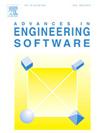CFD analysis and design of bypass dual throat nozzle for high-performance fluidic thrust vectoring
IF 4
2区 工程技术
Q2 COMPUTER SCIENCE, INTERDISCIPLINARY APPLICATIONS
引用次数: 0
Abstract
The purpose of the study is to investigate detailed flow properties of the bypass dual throat nozzle (BDTN) for fluidic thrust vectoring, and to find an optimal geometry to maximize its performance. The performance metrics of the BDTN are defined as the thrust efficiency and flow deflection angle at the nozzle exit. Given the nozzle pressure ratio (NPR), secondary flows injected from the bypass duct of the nozzle create circulatory flows in the nozzle cavity, produce complex interactions of shock and expansion waves, and deflect the directions of the exit flows. To identify key parameters for the BDTN performance, a sensitivity study is carried out using the traditional finite difference method as well as the AI-assisted Shapley additive explanation methods with respect to geometric variables of the BDTN. For the design optimization, a total of eight geometric parameters were chosen including an upstream convergent angle (), a bypass injection angle (), cavity divergence and convergence angles ( and ), upstream and downstream throat diameters ( and ), bypass channel diameter (), and cavity divergence length (). Those parameters were varied by 1020 % of the baseline values to create more than 100 random BDTN geometries which were solved by the full CFD analysis. The multi-variate Gaussian process regression (GPR) model was developed by training the data as a surrogate model to the CFD analysis of arbitrary BDTN shape during the design iteration. Multi-objective optimization was conducted to generate the Pareto optimal front of multiple design candidates for maximum deflection angle and thrust values. The optimum BDTN geometry produced a deflection angle increased up to 13 %, while thrust value was slightly increased from that of the baseline by less than 1%. The approach provides a foundation for future research into adaptive nozzle designs responsive to real-time flow conditions, potentially expanding the applications of fluidic thrust vectoring.
用于高性能流体推力矢量的旁路双喉喷嘴的 CFD 分析和设计
本文章由计算机程序翻译,如有差异,请以英文原文为准。
求助全文
约1分钟内获得全文
求助全文
来源期刊

Advances in Engineering Software
工程技术-计算机:跨学科应用
CiteScore
7.70
自引率
4.20%
发文量
169
审稿时长
37 days
期刊介绍:
The objective of this journal is to communicate recent and projected advances in computer-based engineering techniques. The fields covered include mechanical, aerospace, civil and environmental engineering, with an emphasis on research and development leading to practical problem-solving.
The scope of the journal includes:
• Innovative computational strategies and numerical algorithms for large-scale engineering problems
• Analysis and simulation techniques and systems
• Model and mesh generation
• Control of the accuracy, stability and efficiency of computational process
• Exploitation of new computing environments (eg distributed hetergeneous and collaborative computing)
• Advanced visualization techniques, virtual environments and prototyping
• Applications of AI, knowledge-based systems, computational intelligence, including fuzzy logic, neural networks and evolutionary computations
• Application of object-oriented technology to engineering problems
• Intelligent human computer interfaces
• Design automation, multidisciplinary design and optimization
• CAD, CAE and integrated process and product development systems
• Quality and reliability.
 求助内容:
求助内容: 应助结果提醒方式:
应助结果提醒方式:


